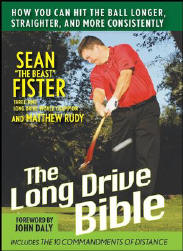The Long Drive Bible: How you can hit the ball longer, straighter, and more consistently
Let’s clear one thing up right away.
I am not a long hitter.
Oh, there are occasions—such as a few 270 to 290-yard run-outs, on the dry, hardened fairways of Myrtle Beach resort courses, such as Farmstead or Tigers Eye.
Those are the distinct exceptions.
On my own course, with its soft, almost cushiony Bermuda grass fairways, I hit my drives between 200 to 220 yards–at the most.
So when world long-drive champion Sean Fister’s publicists sent me his new how-to book, I thought it was a nice opportunity to learn how guys like him can hit the ball the way I just can’t, but that view into another world was all I expected.
What a pleasant surprise.
With his self-effacing tone, Fister’s advice has already helped my game in only a few short weeks.
I’m not hitting the ball a lot longer, but my tee shots are definitely going straighter, and with more consistent distance.
Fister and I are very different in some fundamental ways that also help explain why he hits it so much farther. He’s 6 foot 5 inches and 245 pounds of former Olympic-hopeful pole-vaulting muscle mass. He’s got me by about 9 inches and 80 pounds, and no one ever suggested I should run college cross country or track at an elite level.
He also has a clubhead swing speed somewhere above 150 mph, while mine hovers around 95.
Even so, Fister readily admits that his book is not aimed at helping me make up for the disparity in our physical makeup, by trying to teach me how to swing out of my shoes on every tee box.
Instead, Fister carefully lays out all the different elements of his approach to driving the ball, so that the reader understands how better results come from matching today’s equipment to better techniques.
The most useful part of the book is Chapter 3, “The 10 Commandments of Distance.” In earlier chapters, Fister details how he came to golf from other sports. He decided that he really liked hitting the ball as far as possible, and began keeping detailed notes from his practice sessions on what worked and didn’t work, as he built up his long-hitting resume.
Based on those notes, Fister outlines in this Chapter his approach to the fundamentals of a good golf swing.
As he admits, very few of us will ever match his ability to generate awe-inspiring swing speed through the hitting area. On the other hand, following these tips with whatever speed you can put on the driver should still pay off nicely.
Fister also describes how the long-drive competitions are held, and the kinds of mental and physical preparations that he feels are necessary for good performance. These chapters are also helpful, in that it’s easy to appreciate that his approach to these contests is also transferable to your own level of competition, be it with your regular foursome or in the club championship.
He’s also pretty blunt about the physical toll that long-drive hitting has put on his body. It’s not a medical history that most of us would readily accept as the price of competitive success. For professional athletes such as Fister, however, putting up with the pain is just part of the bargain.
It’s an old adage that you can’t judge a book by its cover. This book is one of the newest examples of that worthy piece of advice. Both long and short hitters can benefit from this informative, helpful guide to better golf.
Review date: June 21, 2008


